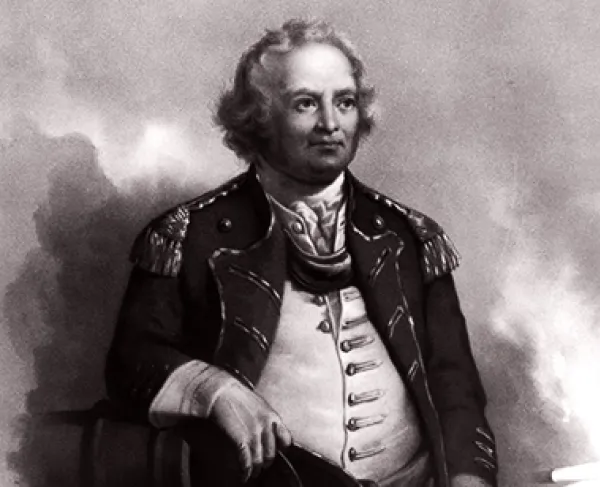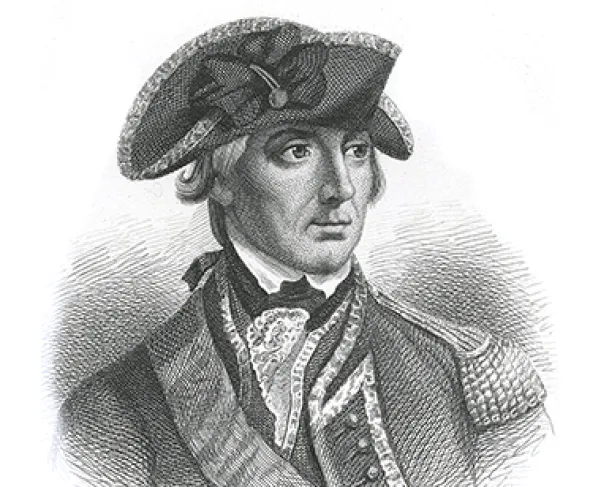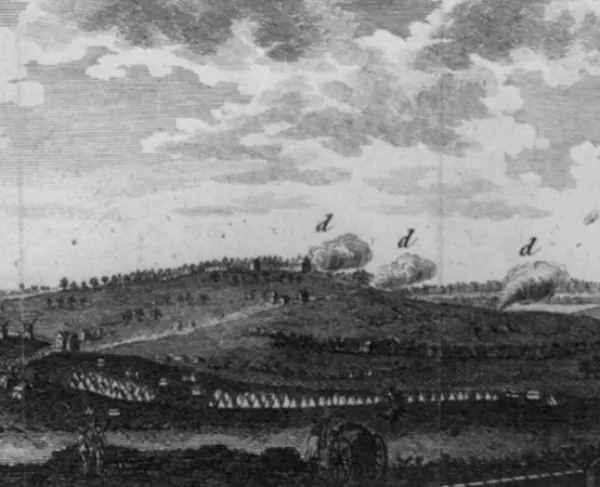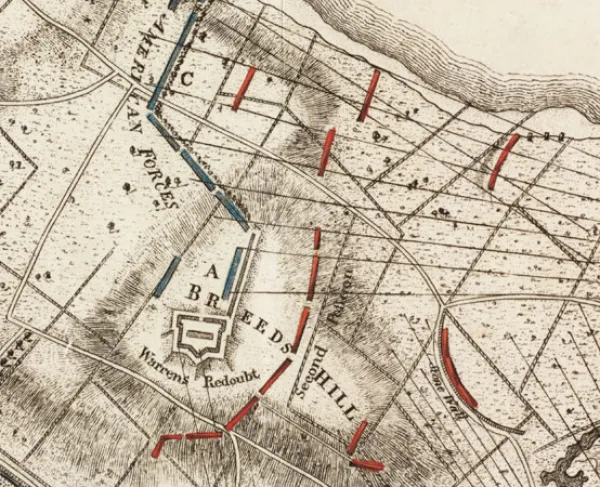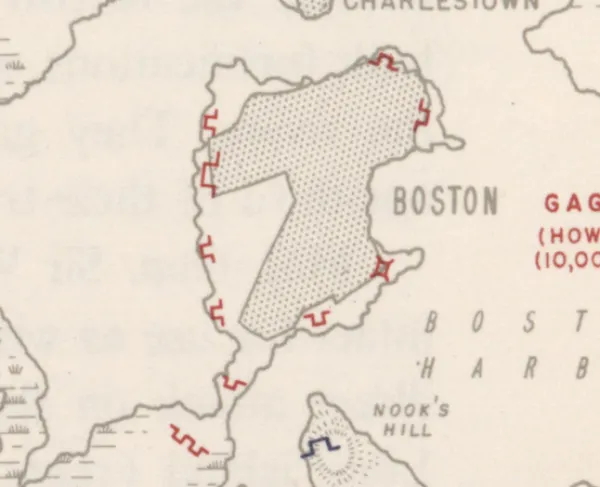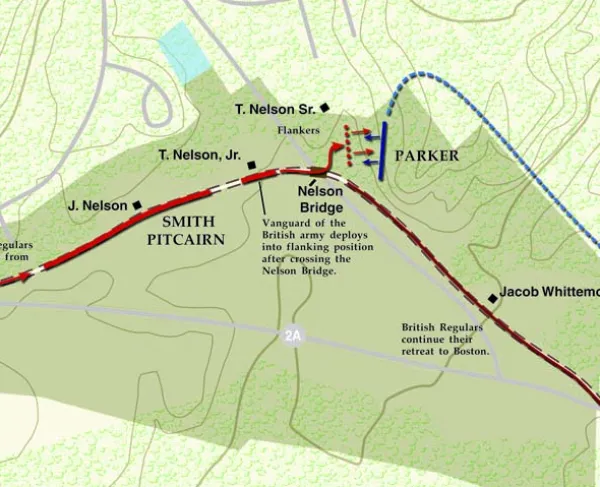Massachusetts | Jun 17, 1775
The American patriots were defeated at the Battle of Bunker Hill, but they proved they could hold their own against the superior British Army. The fierce fight confirmed that any reconciliation between England and her American colonies was no longer possible.
How it ended
British victory. The battle was a tactical victory for the British, but it was a sobering experience. The British sustained twice as many casualties as the Americans and lost many officers. After the engagement, the patriots retreated and returned to their lines outside the perimeter of Boston.
In context
By early 1775 tensions between Britain and her colonies had escalated. The colonists began to mobilize for war, while the British Army secured gunpowder and cannon in anticipation of an uprising. On April 19, it all came to a head in the Massachusetts towns of Lexington and Concord. After that historic engagement, the British retreated to their camp in Boston, and local militias prepared for future British attacks. Militiamen marched to defend Boston, some from as far away as Connecticut, Rhode Island, New Hampshire, and what is now the state of Vermont.
British Commander-in-Chief General Sir Thomas Gage was under pressure to quash the colonial rebellion. By June, he had reinforcements and was ready to implement a new strategy. The British Army planned to launch an attack against the Americans on the heights north and south of Boston. Details of the attack were leaked, however, and a detachment of 1,000 Massachusetts and Connecticut soldiers—more of an armed mob than a military unit—gathered to defend a hill in Charlestown. Among the defenders were several enslaved and free African Americans as well. The violent clash of these forces on what is mistakenly known as “Bunker Hill” signaled that the colonial revolt would not be easily extinguished.
The sheer number of militiamen gathered on the hills outside of Boston deeply troubles Gen. Thomas Gage and his newly arrived subordinates, Gens. William Howe, Henry Clinton, and John Burgoyne. On June 15 and June 16, the Patriots move forward to Breed’s Hill on the Charlestown peninsula, where they prepare a fortified position that all but invites a British response. General John Stark from New Hampshire recognizes that the left flank of the fortified position is exposed along the south bank of the Mystic River. He and his men assemble a makeshift split rail barricade to blunt any flanking action employed by the British. When the British officers look out at what has been erected in the short span of one evening they are stunned. Gage knows he has to take action.
June 17. On this sultry afternoon, Gage and his commanders order British regulars and grenadiers to move across Boston Harbor and disembark in lower Charlestown, where Gage will force the rabble’s hand with an assault. As the British move into position, the fatigued but spirited defenders are on the alert inside their hastily built fortifications.
Led by Gen. William Howe, King George’s troops climb Breed’s Hill in perfect battle formation. Legend has it that as they advance, American officer William Prescott cautions his men not to waste their powder, exclaiming “don’t fire until you see the whites of their eyes.” When British troops near the redoubt, the patriots unleash a withering volley, creating an absolute slaughter. One patriot remarks afterward, “They advanced toward us in order to swallow us up, but they found a choaky[sic] mouthful of us.” It is a veritable bloodbath as the British retreat back to their lines.
Once more the British push up the hill, stepping over the bodies of their dead and wounded comrades who lay “as thick as sheep in a fold,” and again they receive another patriot volley. Finally, on the third try –and just when the patriots run out of powder and shot—the British succeed in breaking through the patriot works. Intense hand-to-hand fighting occurs inside the fortification. The British are victorious but at a cost. At some point in the struggle, a “black soldier named Salem” is credited with killing British Maj. John Pitcairn, the officer despised for allegedly ordering his men to fire on patriots during the battle of Lexington and Concord weeks earlier.
450
1,054
“Our three generals,” a British officer wrote of his commanders in Boston, “expected rather to punish a mob than fight with troops that would look them in the face.” The King’s troops count 282 dead and another 800 wounded. Patriot casualties are less than half of the British total. British General Sir Henry Clinton is appalled at the carnage, calling it “a dear bought victory.” Badly depleted, the British abandon plans to seize another high point near the city and ultimately evacuate Boston.
Though defeated, the Patriots are not demoralized. Those who choose to stay and keep the British bottled up in Boston become the nucleus of the Continental Army. The task of transforming the mob into a fighting force falls on the shoulders of Virginian George Washington, who assumes command in Cambridge, Massachusetts, within two weeks of the erroneously named Battle of Bunker Hill.
In 1775, the Americans marched past Bunker Hill and fortified Breed’s Hill instead. No one knows why they chose a position on the lower hill, but that is where the militias constructed their fort in Charlestown before the battle on June 17. Confusion about the name of the hill where the battle occurred goes back to the battle itself. Colonel William Prescott’s orders were to fortify Bunker’s Hill, but he chose Breed’s Hill instead. A detailed map of the battle prepared by British Army Lt. Page further compounded the problem by reversing the names of the two hills. Over time, everyone forgot about Breed’s Hill, and the famous battle became known by the name of its steeper neighbor.
Fifty years after the battle, the Marquis De Lafayette set the cornerstone of what would become a lasting monument and tribute to the memory of the Battle of Bunker Hill. It took more than 17 years to complete the 221-foot granite obelisk that now stands at the top of Breed's Hill, marking the site where patriot forces constructed an earthen fort prior to the British attack.
There is much lore and contradictory anecdotal material about the death of Maj. John Pitcairn at Bunker Hill, but no air-tight evidence about who actually fired the fatal shot—or shots—that killed him. His death was celebrated by the patriots, who vilified him for ordering his Redcoats to fire on the Lexington militia during the Battle of Lexington and Concord, so there was great interest in discovering the hero responsible for his demise. In 1787, Dr. Jeremy Belknap, founder of the Massachusetts Historical Society, attributed the deed to “a negro man belonging to Groton.” Samuel Swett, writing a study of the fight in 1818, recounted that Pitcairn exclaimed “the day is ours,” when “a black soldier named Salem, shot him through and he fell.” Swett later added that “a contribution was made in the army for Salem and he was presented to George Washington as having slain Pitcairn.”
In 1826, Emory Washburn, writing in the Worcester Magazine and Historical Journal, claimed that a man from his town shot the major at Bunker Hill and his name was Peter Salem. Peter Salem crops up again in 1847 in William Barry’s history of Framingham, the place of Salem’s supposed death. The only problem is that there was another Salem at Bunker Hill—Salem Poor. On December 5, 1775 thirteen colonial offers—including William Prescott, commander at Breed’s Hill—sent a petition to the Massachusetts General Court asking for recognition for “A Negro Man called Salem Poor” who “in the late Battle of Charlestown, behaved like an Experienced officer, as Well as an Excellent Soldier.” Could this man be the “black soldier named Salem”? We don’t know. Perhaps the identities of the two “Salems”—Peter and Poor—merged over time into one man who killed an evil British officer.
J. L. Bell, writing in the Journal of the American Revolution, cites the above sources when considering the Salem issue, but he also includes British versions of the account, which differ from those by Americans. Writing only four days after the battle, Lt. John Waller, adjutant of the first Marines battalion, remembered Pitcairn death’s as occurring before he climbed the fortification on Breed’s Hill where his men “received very heavy and severe Fire from the Enemy” for “”Ten Minutes or a near Quarter Hour.” In the chaos of the moment, Bell observes, Pitcairn may have been hit by multiple shots from various patriot muskets. Among the heroic African American soldiers fighting with the Americans at the Battle of Bunker Hill, one or more may have fired on Pitcairn. Or maybe none did. Americans may have skewed or simplified what actually occurred on Breed’s Hill, and the killing of an arrogant British officer by a disenfranchised black man made for a good story.
Bunker Hill: Featured Resources
All battles of the Boston Campaign
Related Battles
2,200
3,000
450
1,054

